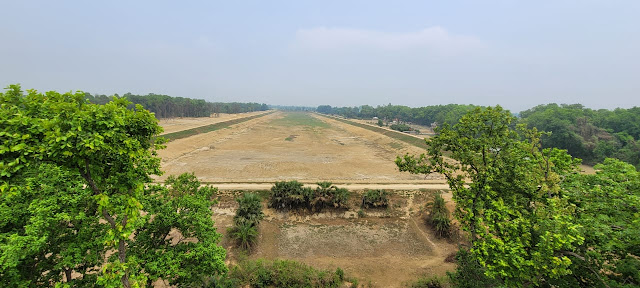‘Our struggle for water is never-ending’

Bidyut Kumar Mondol, a farmer from Kamardha village in Naogaon's Porsha upazila, finds himself grappling with a challenging predicament. He had prepared 23 bighas of land for cultivating Aman paddy, but his dreams have been thwarted by a relentless lack of water.
As the sun scorches the land, and the last two weeks have passed without a drop of rain, Bidyut's Aman lands and seedbeds are withering away.
He has only been able to plant paddy on 4.5 bighas, despite the fact that the monsoon is halfway over, leaving most of his intended area dry and desolate.
"I'm done if it doesn't rain in the next two weeks of Ashar," he says, the weight of uncertainty evident in his voice.
Porsha upazila, like much of its surroundings, heavily relies on rainfall for sustenance, while both surface and groundwater remain scarce resources.
"In the absence of rainwater, we depend on groundwater for irrigation. But even the groundwater is reducing," Bidyut added.
"I can understand that by noticing the increase in irrigation hours and reducing the flow of water," he explained.
According to Md Kajimuddin, assistant engineer of Barind Multipurpose Development Authority (BMDA), the designated 283 deep tube wells help irrigate only 9,252 hectares out of the vast 22,286 hectares of cultivable land in the upazila.
The officials of the Department of Agricultural Extension have also confirmed this information.
With Bidyut's distress reflecting the broader struggles faced by farmers in the region, a looming question remains -- will the skies open up in time to save their hopes and harvests?

FARMERS' STRUGGLES IN NUMBERS
A 2013 study by the Institute of Water Modelling (IWM) suggested the upazila was not suitable for pumping out groundwater due to depletion.
Besides, a recent study by the Water Resources Planning Organisation (WARPO) and IWM shows, Chaor, Tetulia and Ganguria unions of the upazila have no suitable aquifer.
"Extracting groundwater is costly in major parts of the Chaor union," said Nurul Huda, a member of the union parishad.
"We have to dig more than 400 feet to get water. Per hour irrigation costs farmers Tk 150, while farmers in low areas pay Tk 110," he said.
According to Motiur Rahman, a farmer from Boldahar village in Chaor union, a submersible pump costs Tk 10 lakh to install when Tk 3 lakh is enough for places having access to groundwater.
"Moreover, these pumps barely allow us to cultivate 40 bighas of land," he added.
Rahman brings water from one such pump, 3,000 feet (280.84 feet less than a kilometer) away from his village to cultivate Aman on his 16 bighas of land.
Echoing him, Satish Orao, another farmer of the same village said, "Our struggles for water are never-ending... it's a struggle for life."
"Last year, at least ponds and canals had water due to rainfall, but this year, the water bodies are yet to be filled up. A submersible pump that supplies drinking water for some 35 families in my village is also near to becoming empty," he said.
The government installed over 3,000 submersible pumps in villages for drinking water, but the crisis for irrigation water remains, said UP Chairman Sadekul Islam.
Farmers of Porsha and Saahar upazilas converted most of their paddy lands to mango orchards due to lack of water while others cultivate wheat and mustard, said local agriculture officer Sanjay Kumar Sarker.
Mango farming mostly depends on rainwater while some farmers dig ponds near their orchards to preserve groundwater and rainwater for irrigation, said Qudrat E Khoda Md Naser, a development activist.
Groundwater abuse takes toll on Barind
Irrigation water crisis in Barind: Small farmers in a vicious trap


Comments
Post a Comment